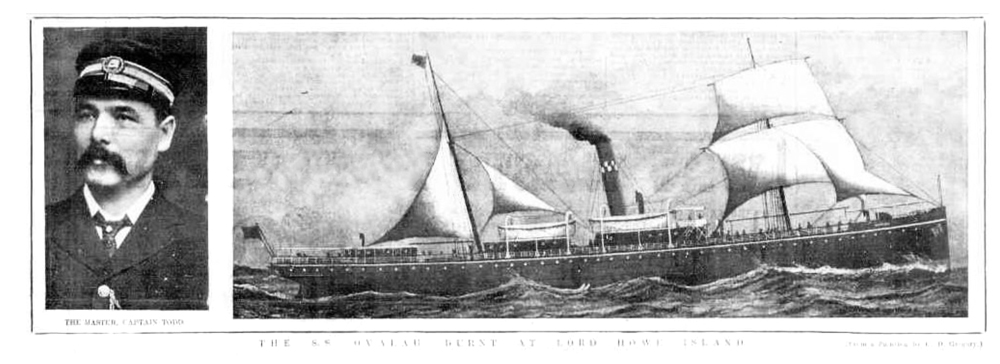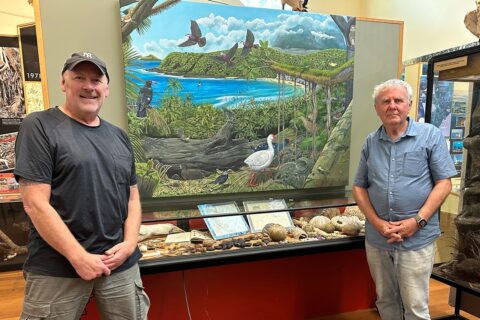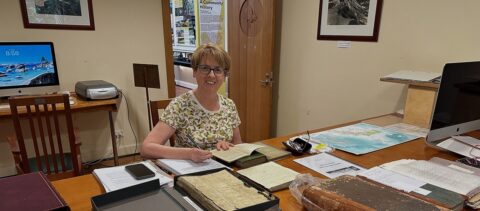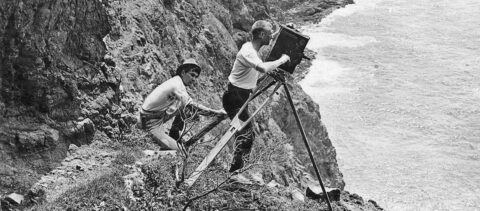More about the history of the SS Ovalau
In October 2023 we had a news item about the Ovalau shipwreck in 1903 – you can read the story, here.
On 19th March this year, David Grogan visited the island and came to the museum to have a coffee with Curator Ian Hutton, and Secretary Chris Murray.
David explained that his great grandfather Captain Charles Todd was the captain on the Ovalau when it caught fire off Lord Howe and sank in 1903. David presented the family history he had been researching for some years.
It is a fascinating story, and the family had a seafaring history in Scotland before coming to Australia. David had uncovered some fascinating details about the event of the Ovalau at Lord Howe Island.

We thought there might be interest form the community about this, so put word around and David gave an illustrated presentation at the museum on Thursday 21st March.
About twenty people attended, including Greg Whitfield, who with his son Ellis, recovered the ship’s bell in 2016. Also in attendance was Gary Payten, whose grandfather Harry was born in December 1903 and was christened with the middle name Ovalau (and that is also Gary’s middle name).
Here are a few excerpts from David’s research…
The Captain’s story
“We were about 100 miles from Lord Howe Island on October 18, en route to Sydney from other island ports. At this stage of the trip it was reported to me that smoke was issuing from the forhold. An investigation was made in a quiet way, and steps taken to prevent the fire spreading. The passengers knew nothing about it, so quietly, was the report made to me. The steamer kept on her course, and we reached Lord Howe, bringing up at the usual anchorage, on the west side of the island. The passengers—the ladies and some of the men were landed, it being my intention to make for Sydney, where I knew I could get the big pumps at work. There was no scene; in fact, some of the passengers did not want to leave the ship at all. Meantime, another examination had been made, and after that the ship was ready to leave for Sydney.”
Continuing, the Captain said: “We were in the act of heaving the anchor, when a report was heard. In a minute it could be seen that the forward hatch was blown up. The fire had now got a pretty strong hold, and was going through the ship. Before we left it had extended to the bridge, and to my cabin. Nothing was left but for all hands to get out, and the boats were swung out. There was no chance of saving the ship. When I left the ship, the fire was breaking out in the saloon aft. The sails of the little boat alongside were on fire, and then we left. When we landed there was another explosion, this time the boilers having gone. From the shore we watched the ship burning, and the masts came down at 4 in the afternoon of the 19th instant. She floated till 4 o’clock the next morning, and then went down at the moorings.
The loss is a severe one to all concerned. The ship is valued at £15,000, and she is only covered to the extent of £13,000. The value of the ship and cargo might roughly be put down at £25,000. The cargo by the Ovalau consisted of 220 tons ivory nuts, 395 tons copra, 17 tons pearlshell, 7 tons maize, and 38 tons sundries.”

This sketch was made by a crew member as the Ovalau was burning at anchor off the reef at Lord Howe Island. It shows the violence of the explosion that tore great holes in the steel hull of the ship and caused it to sink in 10 to 12 fathoms of water.
Captain Todd’s role in the rescue was recognised by the presentation to him of a gold medal in Sydney the following year. “Presented by Sir John See K.C.M.G, Premier of New South Wales, on behalf of the Government to Captain C.W. Todd as a mark of appreciation of his gallant and meritorious exertion in rescuing the passengers and crew of the steamship Ovalau at Lord Howe Island on October 19, 1903.
The Salvage Operation
From: Sydney Mail and New South Wales Advertiser, Wednesday 3 February 1904, page 293
The steamer Maud Weston, which has been engaged in connection with salvage operations at the scene of the wreck of the steamer Ovalau, off Lord Howe Island, returned to Sydney on the 23rd ult. Captain Joseph Weston, of Balmain, who purchased the wreck from the underwriters, visited the scene in the steamer Sophia Ann in December, but it was found that the vessel had turned turtle, and was lying upside down. After recovering some gear, a return to Sydney was made for a supply of dynamite in order that the wreck might be blown up. A second expedition was then organised, and the Maud Weston, in command of Captain Auland, and with Captain Weston and divers Anderson and Clarke on board, sailed from Sydney on the night of the 4th ult, reaching the scene a few days later. Operations on this occasion were attended with a good deal of success, for the salvage steamer has returned with a large quantity of valuable gear.
The divers found the Ovalau lying bottom upwards in a slanting position. Several 50lb charges of dynamite were exploded in order to break up the vessel, and altogether eight cases of dynamite were used. The bronze propellor was removed by means of a heavy charge and recovered intact. Six anchors were also obtained together with 225 fathoms of cable and about 95 fathoms of small chain. Some boat davits and blocks were also secured. The side of the wreck was blown open in order to effect an entrance to the engine-room, but the only thing of any value secured there was a small engine. Large quantities of melted copper, brass, lead, etc., were found and hauled to the surface. An attempt was made to obtain the cargo of pearlshell, but its whereabouts could not be located. Captain Weston is of opinion that there is nothing more recoverable, and operations have now been abandoned.
The figure below shows how the divers were maneuvered over the wreck suspended between two rowing boats, one of which contained two men cranking an air supply pump through a pipe down to his “hard hat”. Dynamite was used to remove the brass propellor which was salvaged and sold.







